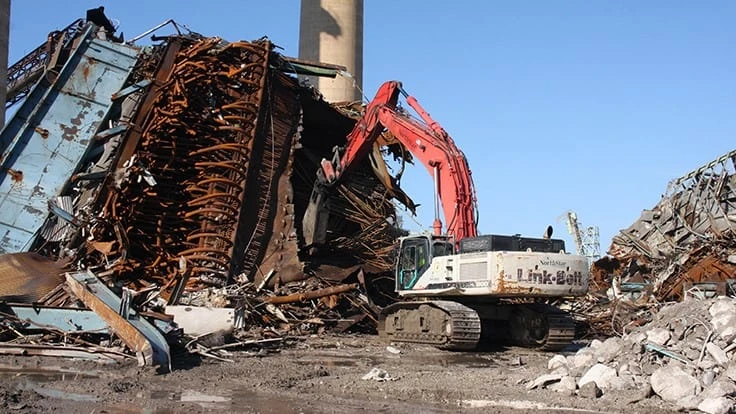
Photos: Northstar/Trojak Communications
Faced with stricter environmental regulations, low market prices and an acceptance that climate change is a reality that’s already upon us, energy companies are increasingly turning away from coal in favor of alternative sources of energy such as wind, solar and natural gas. This sea change has created a boon of sorts for demolition professionals, as key coal-fired plants throughout the U.S.—and the world—continue to be decommissioned at an increasing rate.
One such plant is Duke Energy’s 1960s-era coal plant in Crystal River, Florida. NorthStar Contracting Group Inc., the New York-based firm in charge, is drawing upon a combination of traditional and innovative technologies—including a pair of powerful mobile shears—to deal with the site’s imposing material and keep the project on track. NorthStar is also majority owner of Accelerated Decommissioning Partners, which is decommissioning the Crystal River Nuclear Plant that was retired in 2013.
End of the line
Owned by utility giant Duke Energy, the Crystal River site of today pales in comparison to its former self, which once relied upon a quartet of coal-fired plants and a nuclear facility to provide a combined 1,775 MW of power to Florida and beyond every year. Today, its electrical output from coal-based sources has been reduced by almost a gigawatt, and its 860 MW nuclear component was decommissioned in 2013. To help offset the coal and nuclear power losses, the Citrus Combined Cycle Station was opened in 2018. The natural gas-fired plant provides 1,640 MW of power. Thanks to its cleaner energy source, the station will reduce sulfur dioxide and nitrogen oxides emissions by 90 percent compared to the coal plants it replaced.
Workhorses in their time, the site’s Unit 1 and Unit 2 coal-fired plants, which went online in 1966 and 1969, respectively, were kept in operation until 2018. In 2019, NorthStar began a year’s worth of asbestos abatement followed by prep work for the implosion of the boiler buildings. In June 2020, Phoenix, Maryland-based Controlled Demolition Inc. used 500 explosive charges to reduce these structures to a massive pile of debris.
“These were impressive structures: Unit 1 measured 120 feet by 100 feet by 200 feet tall, and Unit 2 was even beefier at 120 feet by 120 feet by 220 feet tall,” Matt Banta, NorthStar’s project manager at the site, says. “In less than 10 seconds, they were on the ground and our real work could start. All the material in a place like this is as stout as it gets. So, while there were the normal catwalks as well as some lightweight exterior walls that we removed, all of the interior material is just ridiculously beefy.”
Not one to overstate things, Banta cites beams from which the boilers hung that measure 12 feet tall with 3-inch-thick steel between the web and the flange. Additionally, steam lines that run throughout the structure are several inches thick, and the drum for the boiler has walls that are 6- to 7-inches thick.
Selective cutting
Facing a pair of 60-feet-tall piles of steel—one from each erstwhile boiler house—NorthStar began the tedious process of turning that compressed, oversized block of debris into manageable, transportable scrap. To make that happen, Banta and his team called upon a pair of mobile shears from Superior, Wisconsin-based Genesis Attachments that were purchased through the Ocala, Florida, branch of Linder Industrial Machinery, Plant City, Florida.
“We have a Genesis GXP 660R MAXX mounted attachment on an 800 Series Link-Belt that has been an absolute demo machine for us,” Banta explains. “We have that for most of the upper-reach material, and then [we] team [that] up with a Komatsu PC490LC running a Genesis GXP 990R MAXX. We are still having to torch a lot of material, simply because there is no shear at work today that could process some of this steel—a good deal of which is plate. But the 990 has really impressed us with what it’s been able to cut. Together, the two attachments have been giving us some outstanding production.”
Banta notes that the excavator-mounted shears are instrumental for effectively dealing with the massive boiler house debris pile. With the Genesis shears, his operators can reach up, pull down material, cut it to a manageable size and pile it for loadout. If they encounter material that is beyond the shears’ capacity, they simply set it aside for the burners to tackle later. Through this process, progress continues unabated.
Tanks for the memories
Impressive though they might be, the project at Crystal River is about much more than simply those two boiler buildings. At the time of this writing, NorthStar still has a to-do list that includes demoing a massive two-story pump house and a tank farm on the southern side of the site. Previously, the company processed a series of storage tanks using the shears: two of which were 240 feet in diameter and 50 feet tall, and one which was 200 feet in diameter by 50 feet tall. An identical tank, which still contains water that NorthStar is using for dust and fire suppression, will be one of the last structures to be demolished.
“We sheared the tanks from the top down to about 20 feet from the ground, at which point, the material gets very thick—in the 1.5 inch and larger range,” Banta says. “So, we would grab the interior columns, bring them down, shear the tank cover, bring the walls down to a certain point and then cut the walls into manageable pieces. Doing so, we were able to have a tank completely processed and shipped off in about two weeks.”
Having recently processed a pair of large tanks in South Florida without the benefit of mobile shears, NorthStar had the unique opportunity to compare the effort with and without the hydraulic attachments. The contrast was stark, according to Banta.
“In that other setting, we had to devise an elaborate plan in which we had cables attached to each column, then cut the collars,” he says. “We would then use machines to pull the cables and trip the roof—that alone took about two weeks. Then, once the lid was done, we had another two weeks of work to get the walls down. So, the process was easily twice as long—and far more labor-intensive—as it was using the shears.”

Weighing in on volumes
Rather than taking material down to a prepared size, NorthStar is instead only required to downsize it enough to fit in the fleet of trucks servicing the project. Banta says they are loading between 12 and 20 trucks a day—each one maxed out at 80,000 pounds, including the weight of the truck.
“We actually bought and installed a scale here on-site to ensure no one is overweight before making the trip to the scrap yard,” he said. “If they are over—or under, for that matter—we send them around to have some material taken out or added. Maximizing each load at that 75,000 to 80,000 pound overall weight means we are shipping 35,000 to 40,000 pounds with each truck, and it’s a steady stream of trucks heading both ways.”
Even the loadout facet of the job has been something of a challenge for NorthStar. Banta says that, in some cases, they have had to downsize the steam pipes just so the grapples or the buckets with thumbs could handle them. Because the larger beams weigh a couple thousand pounds per foot, even a 5-foot length would be pushing the limits for the machine to pick up and place into a truck.
“To put the scale of this project—and the material—into perspective, thus far we’ve trucked more than 23,000 tons of steel out on a 3-hour roundtrip to a scrap yard in Tampa,” he says. “We are estimating that the total volume will be in the 32,000 ton range when the job is wrapped up. That is some serious tonnage.”
Toppling a landmark
Approaching the point at which they are two-thirds complete with the project, NorthStar’s work has also included the demolition of seven buildings, one of which was a turbine hall that measured 80 feet tall by 300 feet in length, an ash silo and precipitators. The pump house and tanks still remain to be demoed, as does a conveyor bridge that was once used to move coal to the boilers. Perhaps the most high-profile facet of the job will be the implosion of the plant’s two 500-foot-tall stacks.
“We are planning to implode those in November,” Banta says. “Because of limited room on-site, we can’t bring them down the way we’d like without a part of them ending up in the canal. Instead, we will crisscross them when they come down. Their demolition will definitely be a loss to fishermen and other boaters in the area who’ve come to use those stacks as a navigation landmark.”
Wrapping it up
Before they could move on to the final site grading facet of the project, NorthStar also had to address all the large-diameter subsurface piping that runs throughout the site. A combination of a contract stipulation and the area’s high water table dictated their approach, says Banta.
“There was a discharge canal that we had to cap in addition to the discharge piping that led from the turbine hall to the condensers and out to the water,” he says. “Those were 5-foot diameter concrete pipes that were buried several feet below the surface. Our contract only goes to 2 feet below grade and states that, if we left those pipes in the ground intact, they’d have to be filled. So, we had the choice of going 10 feet down, breaking up the pipes and removing them, fighting water all the time, or just filling them up. We chose the latter and flow-filled them all with a soil-cement slurry.”
He adds that work on the pump house and the remaining tanks will probably take four to five weeks and be very shear-intensive. Because the material throughout the site is so stout, the maintenance regimen on the company’s shears is adhered to almost religiously, he notes.
“Those tools run almost continuously, every day of the week we are out here,” Banta says. “So, every two to three weeks, we rotate the blades to get the best performance and keep production rates up. Similarly, because they are taking a lot of abuse, we always order additional piercing tips along with our new blades. Thus far, the only real idle time we’ve had with the shears is when they are undergoing a blade rotation or changeout, so that level of preparation has paid off. On big industrial jobs like this, you literally can’t do without good mobile shears, and we feel we have some of the best in Genesis.”
At the time of this writing, NorthStar expected to have all the steel removed from the Crystal River site by the end of October and be completely wrapped up at the site by fall 2022.
This article originally appeared in the Nov. Dec. issue of Construction & Demolition Recycling. Larry Trojak is the owner and president of Trojak Communications, a Twin Cities-based specialist in marketing communications and content creation. He can be reached at trojakcom@gmail.com.
Latest from Construction & Demolition Recycling
- Evoquip adds trommel screen to product line
- Bomag to showcase innovations on the National Mall
- NWRA, SWANA to partner on safety, education and advocacy
- Caterpillar announces collision warning system, other technology for medium wheel loaders
- ABC: Nonresidential construction adds jobs in April despite headwinds
- Demolition underway at former SC steel mill
- Turkey neglects US scrap in favor of Russian shipments
- Results of New Hampshire waste study reveal missed opportunities for diversion





